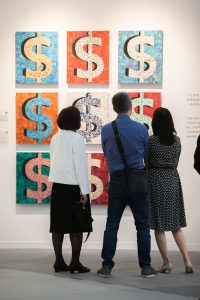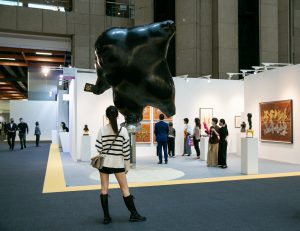Interviewer/ Chang Yin-chiang
Collated by/ Yizai Seah
Many reports from various sectors show that the pandemic has caused inflation to reach its peak in the past four decades, affecting the art market to some extent. The international art auction market has hit record highs repeatedly in recent years, but this phenomenon occurs under specific conditions. Understanding the true trend within the broader art market remains a challenging task.
In this interview, the head of New Age Art Gallery, Mr. Chang Yin-chiang, was invited to discuss the actual impact of inflation on the art market and consider how Taiwan should position itself in the global art market.
What exactly does inflation affect?
Chang Yin-chiang believes that the essence of inflation is actually a market phenomenon manifested by excessive issuance of currency. He stated, "After the era of financial and industrial capitalism, artworks have become an option for high-net-worth individuals to allocate their assets. so the value of art benefits in an age of inflation, which has led to spillover effects for the richer bourgeoisie." In this context, the prices of works by art masters have increased with the times, and the factors influencing these prices cannot be separated from the wealth effect resulting from increased currency issuance.

Artworks have become a part of asset allocation for high income bourgeoisie in the financial age - a glimpse of the ART TAIPEI 2021 art fair.
During the pandemic, in order to prevent its spread, physical events around the world were brought to a halt. However, at the same time, this enlivened online art exchange events. Cryptocurrencies, NFTs, online trading platforms, online exhibitions, etc., all benefit from the speed of communication on the Internet, which created chic art trends; the traditional, physical sectors can barely hold a candle to any of these areas. Hence, although habits and patterns of consumption have changed, the motivations and purposes for consumption stay rooted in the constant aspects of human nature.
Although collectors are beginning to wait and observe the new consumption model, the central issue still revolves around the core question of what motivates their collecting. “In the inflation and post-pandemic era, collectors' primary concerns remain focused on the future development and potential of the artworks they acquire, as well as the direction of current trends. Are these matters still within their expectations?” Here, Mr. Chang put aside the external concerns brought on by inflation, and instead turned to the real inner concerns. What perspective and vision should individuals adopt to shield themselves from the potential crises of the times?

The motivation and goal of consumption are caused by human nature that has remained constant.
How to open up a wider perspective for investment strategies?
In the era of global competition, one must look at it from a global perspective. Chang Yin-chiang believes that it is necessary to see it from three perspectives: macroscopic, mesoscopic and microscopic. "Macroscopically, it observes major regional politics, economy, culture, and industrial structure trends. Mesoscopically, it clarifies trends in different art categories, such as the evolution and context in terms of history, civilization, and the development of an age and era. Microscopically, it is the choice that differentiates between various artistic brand marks, whether it is the issue, connotation, form or viewpoint of the work, etc.”


A globalized perspective: the choice between a macroscopic view of observing regional political and economic trends and a microscopic view of difference between artworks.
In order to be able to stand one’s ground in the art market over a long period of time, one must take the path created by art history. Chang Yin-chiang discovered from historical experience that so-called "crises " actually are "opportunities in crises", because every crisis of the times will bring about the change in the guards, allowing new art categories and mainstream artists to come in and replace the old. Just like in the 1990s during the Taiwan Strait crisis, when there were stock market and real estate market bubbles, overseas Chinese artists in those early days began to blossom and flourish due to the low prices of their works. The SARS and global financial crisis in the 2000s led to the explosive surge of Chinese contemporary art and modern ink paintings. After the European subprime crisis and the collapse of the Chinese stock market in 2015, Asian Neo-Pop, graffiti and urban art swept the market. Therefore, is it possible that the next cultural and art revolution in Asia will take advantage of such future crises again?

After 2015, Asian Neo-Pop swept through the market (photo from ART TAIPEI 2016)
Why do we need value and consensus?
When it comes to how artists emerge from the market, it is also closely related to the "intrinsic value" and "collective consensus" of artworks. The so-called "value" is actually a kind of perspective on values. Chang Yin-chiang used the postwar economic and social changes in the United States in the 1960s to illustrate the rise of Pop Art. "Under the updated concept of contemporary art, mass reproduction became the norm, and popular culture has also developed as an important trend. Therefore, what pop art sold was actually the perspective based on the values of 'freedom, democracy, and equality.'" When asked what kind of ‘value’ Taiwanese artists should put onto the market to gain a competitive advantage, Chang commented that artists probably still need to find their own culture, something truly Taiwanese.

The entire Chinese civilization is the root of our profound value system.
"Retrospecting our Chinese cultural traditions, Confucianism, Buddhism and Taoism have long been part of our culture. The entire Chinese civilization forms the unshakeable bedrock of our values, and the essence of its ideology can be applied to different civilizations to foster collective consensus. If it does not continue to develop, and we instead blindly follow the trend of Western modernism, it will be difficult for us to hold onto a position and our own values as Asians, as Taiwanese, in the long run." However, rather than resisting the West and returning to the East, Chang Yin-chiang is more concerned about how we "combine" the spirit of different cultures, "Whether it is what Einstein once said about the creativity of combination, or a small iPhone, both incorporate the technology and wisdom of various inventors of the past, serving as remarkable examples of fusion and grafting."

Fusion and grafting – the “MIT-Taiwan Young Artists Connection with the World” special exhibition,
where works combined the Taiwanese altar table culture and American comic.
Art can borrow, apply or appropriate knowledge, concepts or methods from non-art fields, thereby integrating and assembling them to become new directions for the future. In addition, the art market must also evolve new marketing models in addition to its content. Among them, innovative combos of financialization, new business models, and marketing planning orientation are all areas that Taiwan has always needed to pay more attention to and strengthen.
Over the past thirty years, ART TAIPEI, as an important international art platform in Taiwan and the Asia-Pacific region, has weathered the financial crisis and witnessed ups and downs in the market. A new generation of artists and novice collectors has entered the market one after another, which coincided with the 21st-century pandemic and the transformation of market strategies in recent years. The future art industry will be pushed towards more diverse developments. No matter how the environment and circumstances change, the "assembly" suggested by Chang Yin-chiang is actually seeing turning points in the future by examining the roots and history of civilization. For Taiwanese artists, it is even more vital to find ways to set themselves apart from others, and to construct a new set of artistic principles and methods of appreciation, so that they can create works that represent the times they live in.
